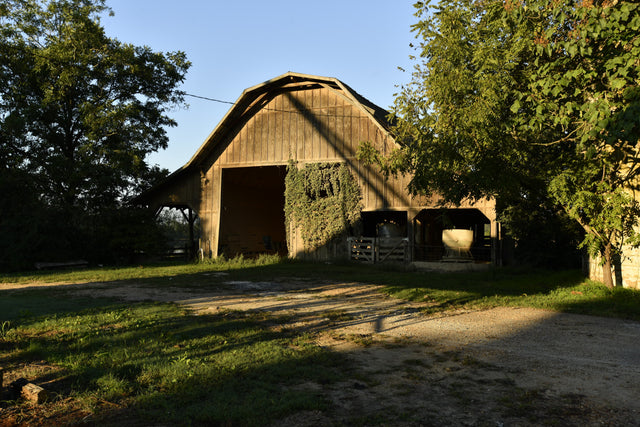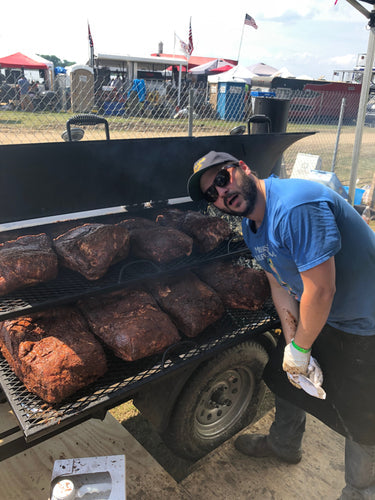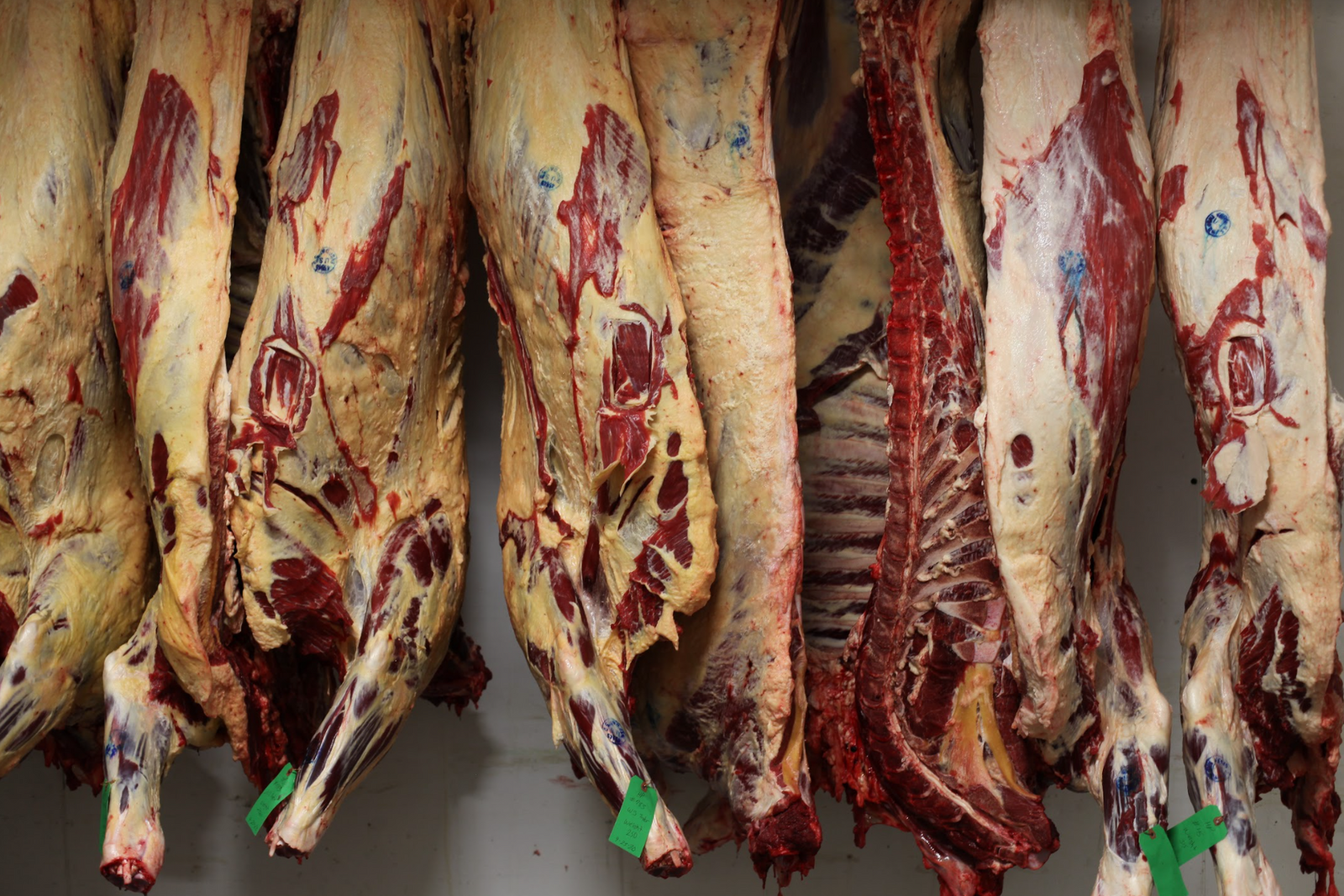
Almost daily I have farmers across the region call and ask, “what did it take to go federal?” or “how much would it cost me to build my own plant?” or “I can’t find anywhere to slaughter and process- how hard would it be for me to do it myself?”. My answer is always the same: do NOT build a slaughterhouse. If you can find a place to slaughter for you, just build a little cutting room with a walk-in cooler and freezer to do your own processing under inspection. Why do I recommend this?
Disclaimer: I’m going to discuss the technical details of slaughtering at Home Place. Some folks may find this graphic.
The Humane Slaughter Act was originally passed in 1958 and later amended in 1978. After animal rights groups and journalists documented atrocities committed by larger-scale plants with apparent impunity in the early 2000s, an additional amendment was passed and signed by George W. Bush as part of the 2002 farm bill. The 2002 amendment added some teeth for enforcing the existing law and increased the budget for the Food Safety and Inspection Service to hire more on-site inspectors and veterinarians to monitor for violations.
At the core of the Humane Slaughter Act is the requirement that an animal is rendered completely unconscious and insensible to pain before it is exsanguinated (bled out). To enforce this law, FSIS has front line inspectors who witness every stun and bleed out in plants that are federally inspected. If an animal shows any hallmark sign of sensibility after it is stunned (vocalizing, attempting to stand or right itself, rhythmic breathing, eye tracking/ blinking), the inspector halts slaughter, issues a Non-Compliance Record (NR), and sends the report to the district office. The district office then uses specific criteria to determine whether to suspend the establishment or to allow the establishment to continue operating if they provide a response and corrective action within 3 days. If the NR report describes a scenario where multiple attempted stuns failed to render the animal insensible, or an animal was stunned effectively and then exsanguinated, but showed a hallmark sign of returning to sensibility before it died, the district office will immediately suspend the plant.
If a plant’s slaughter activities are suspended, the plant must submit an extensive overview of what happened, why, and how management will keep it from happening again. The point here is to identify the root cause of the humane handling failure, lay out specific steps to prevent a recurrence, and describe how those steps will be documented and verified so the inspectors have a record to check.
This regulatory system is clearly necessary to prevent cruelty to animals in the slaughter industry, where historic indifference to suffering has created horrifying conditions for both animals and people. This information is also available to the public to bolster transparency.
However, I would like to lay out how this act can play out on the ground for small operators and argue that, despite its necessity, this act has contributed to the disappearance of local and regional plants. It has also created the unintended externality of centralizing our food system and empowering the handful of massive companies that control our meat production.
While the amount of red meat produced under federal inspection has steadily increased each year since the early 1990s, the number of federally inspected slaughterhouses has steadily decreased¹. In 2019, the U.S. produced 55 billion lbs of red meat². At Home Place’s current production, we represent 9 ten-thousandths of 1 percent of US production or .0009%. The biggest 4 companies produce 80% of this staggering volume of meat. I’m not sure statistics can fully address the differences in the size of companies governed by the same set of regulations. Consider this: a Smithfield plant in North Carolina can kill 10,000 pigs per day (some plants can do significantly more than this since new line speed restrictions have been lifted in the last year). Since Home Place began slaughtering in its own facility, we have slaughtered and processed roughly 3,250 pigs in 2.5 years, or about 25 per week. Our entire output for 2.5 years could be slaughtered in a Smithfield plant in less than 3 hours. This helps to explain why commodity meat is so cheap, but that is a separate issue we’ve discussed and will discuss again in a different post.
In these high-speed plants, you still have one inspector witnessing the stun and stick process, except this is occurring at a pace of 1 pig every 2 or 3 seconds set by an automated line system. In our plant, one inspector also watches each stun, except we work all our animals into the restraining system and stun them individually, by hand. On some days, I’ve had as many as 4 USDA employees watch us slaughter 3 steers. Compare 1 inspector for 10,000 head per day on an automated line vs 1 inspector for 20 hogs per day with one manager handling and stunning the animals.
My point is that small federally inspected plants that in most cases actually care about the welfare of their animals have an extremely unfair regulatory burden. We cannot afford to make one single mistake, ever. If we do, we are suspended and our miss-stun becomes public information, which animal rights groups can use to manufacture sensationalized news stories*. On the automated lines, the animals are flying by so quickly no one can tell what's going on and the inspectors can’t slow the process down to take another look or investigate.
In addition to exponentially higher oversight for a tiny percentage of volume, small plants also cannot afford the automated line systems and advanced stunning technology (carbon dioxide chambers or sophisticated electric stunning equipment) that the large companies utilize. We have to use captive bolt guns (these are still not cheap, around $1200 apiece) and hand-operated electric stunners for hogs (our model costs around 6k). When we electrically stun, we keep a captive bolt loaded and ready as a backup in case there is a failure with the electric stunner. When we stun cattle, we have two captive bolt guns in case one fails. Many older plants operated by highly skilled and experienced owners still use just a .22 rifle to stun, because that’s how they've done it for decades. At Home Place, we test and maintenance stunning equipment daily as part of humane handling and HACCP plans. We conduct monthly re-trainings on determining signs of insensibility and simulate failures to make sure we are ready to end an animal’s suffering immediately if a failure occurs. Despite our best efforts, mistakes, even if they are momentary, can still occur.
If we miss-stun an animal during slaughter, there should absolutely be consequences. We have had 2 miss-stuns in the almost 3 years that we have been in business; 2 animals out of over 5000 total stuns for all species (lamb, goat, hogs, cattle) over 2 and a half years have arguably felt momentary pain before we effectively rendered them unconscious. In both cases, we were suspended.
In both cases, we had equipment failure that led to the animal briefly (a matter of seconds) righting itself before being effectively stunned. Though the animal did not vocalize in either incident, the attempt to stand is a hallmark sign of consciousness and is a clear violation of the Humane Slaughter Act.
These incidents keep me up at night. I fully own the responsibility for these failures. We do not view our slaughterhouse as a stand-alone business of industry, but rather as an extension of our farming operation, where our animals are cared for from birth to death. The buck stops with us for every part of this process, including slaughter. While this makes our business unique, it also gives us a tremendous amount of responsibility. In these two cases, we failed not only from a regulatory side but from an internal value standpoint. Federal law and animal welfare standards aside, if our kill floor is suspended we also suffer intense financial consequences.
Perhaps the above gives a better insight into why small slaughter facilities are hard to come by: regulations in response to genuine atrocities and public outcry have concentrated in potency at the very bottom of the supply chain in terms of volume, instead of at the top, where almost all of our meat comes from.
The point is not that these regulations should not apply to small operators: an animal should never have to experience pain because of human error, and if it does there should be consequences. However, all of the regulations, emotions, passions, energy, and consumer concern should not disproportionately affect small operations that produce a teeny tiny amount of the 50 plus billion pounds of meat sold in this country each year. The result of our current situation is that the giant plants slaughtering the vast majority of the animals we eat (and often committing some of the hellacious animal welfare conditions that brought all the attention to this issue in the first place) operate with impunity while the little guy is squeezed out. These companies are often owned by multinational conglomerates headquartered in other countries (Smithfield, Creekstone, JBS). These companies continue to merge and consume each other, leading to unprecedented industry concentration.
These companies often import meat and have no consumer traceability or accountability (the plant number on the package only tells where the product was re-processed or labeled for retail, not where it was slaughtered or processed initially, sometimes multiple times, and often overseas), and they have the resources to lobby for murky food labeling policies to mislead consumers.
For the small guys, we have comparably little cash reserves or resources, we create jobs in rural communities, we create more revenue for local farmers, we care about our animals, we pay taxes, we have per carcass regulatory presence exponentially higher than the industry average, and we are DIRECTLY ACCOUNTABLE for everything that happens to our product. You can call us about any issue you have with our product, knowing we slaughtered and processed it right here. Facilities that slaughter less than 1 million animals per year collectively make up less than 10% of total annual slaughter volume, but damnnit we are here to stand behind that 10 percent (in our case .0009%)!
I wish that animal rights activists and small farmers could join together to help decentralize the industry, bolster regional and local food systems, to make our food supply more diverse and safer. The winners here would be our rural economies, employees, the nation’s food supply, the environment, and, of course, the animals!
I would not run a slaughterhouse if it was not an extension of a farming process. These two things have become too disjointed in our modern food system. For Home Place, slaughter is the critical process connecting our customers to our farming practices. To regenerate our land and run our farm like an ecosystem, we have to use hogs and ruminants to recycle nutrients and harvest plants, enhance soils, and sequester carbon. To generate revenue to continue regenerating our land, we have to sell meat. To sell meat, we have to slaughter and process the animals under federal inspection.
I don’t know a farmer who enjoys killing things, or who doesn’t have a reverence for life. I don’t even enjoy hunting anymore: a gradual change since I started this business 7 years ago. As a boy on the farm, I loved to hunt and to harvest a steer each year for our family. Hunting and butchering meat with my father for our family taught me to respect the work and skill required to properly utilize an animal once you have ended its life. The only way to justify and cope with the visceral experience of taking its life is to use every part of it as food, as predators do in all ecosystems.
These days, especially following our career second miss-stun about a month ago, I’m on the edge of my seat, always waiting for a captive bolt cartridge to misfire or a simple mistake to cascade in a moment of adrenaline and panic into a miss-stun scenario that will shut my entire business down. Fortunately there are some resources for small plants. The USDA provides outreach to small plants to help comply with the HSA, and we are in the process of utilizing every resource available to constantly improve this crucial aspect of our business. We also remain committed to transparency. We give tours of our slaughter facility (though not during slaughter because of food safety and liability concerns), openly discuss our slaughter methods with our chefs and customers, and own up to mistakes.
My point in writing this is to educate, but also to argue for a slight revision to the HSA. I do not think we should change the tenants of the law, but I do think that regulators should take more into consideration during a miss-stun situation. A small degree of subjectivity should inform enforcement actions. If a plant employee miss-stunts an animal and blatantly disregards this animal’s suffering/ makes no attempt to quickly end this suffering, this is surely an egregious act of inhumane handling. If a mechanical failure leads to a miss-stun and the employees immediately attempt to end the animal’s suffering, the actions and demeanor of the employees following this failure should be taken into consideration.
From this lens, I truly believe that small plants will outperform the big plants every time. The lack of empathy one must feel after seeing 10,000 animals die on a massive assembly line is hard to comprehend. I cannot imagine what an inspector feels trying to “regulate” that unstoppable river of carcasses flying by. I do, however, know exactly how I feel as I stand on the Home Place kill floor with our inspector and watch Carlos ease an animal I’ve raised from birth into our knock box, stun it, bleed it, and watch it meticulously for any sign of returning to sensibility as it bleeds out and dies. I will never become numb to this experience, and everyone on the Home Place team feels the same. I hope that we can concentrate this same level of accountability to the companies who truly control our meat industry, and give small operators more room to grow, learn from their mistakes, and make our food system healthier, more humane, and less centralized.
Thanks for reading and supporting our farm!
Marshall
²https://www.statista.com/statistics/219109/us-commercial-red-meat-production-since-1990/
*PETA writes a formulaic media release everytime a miss stun is documented by FSIS and publishes it on their website, always ending with a pitch to go vegan. They also send the story around to local news outlets.
More stories

HR should stand for hard & robust, am I right?


